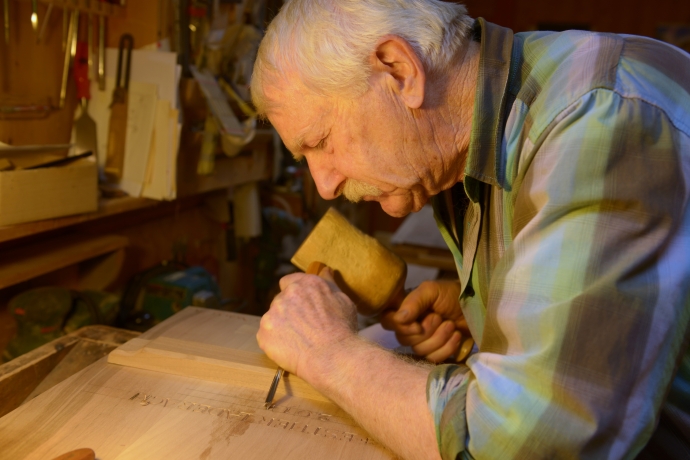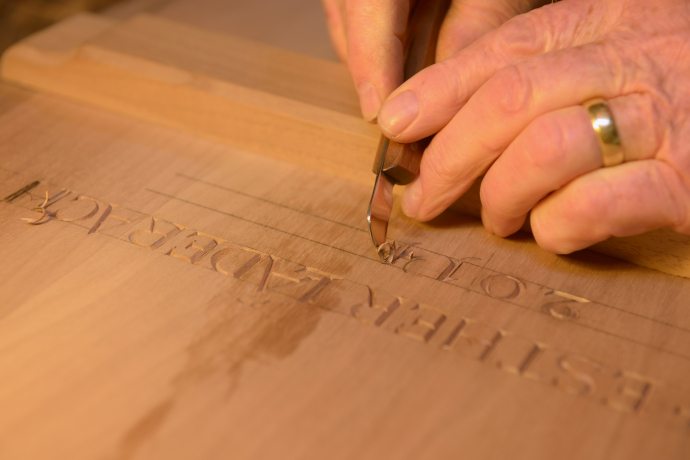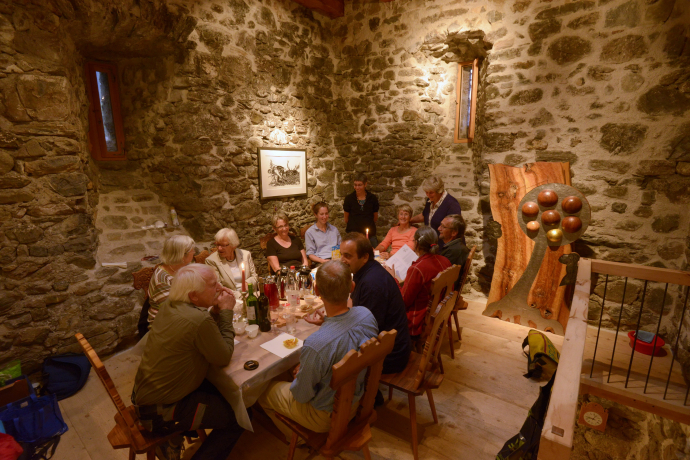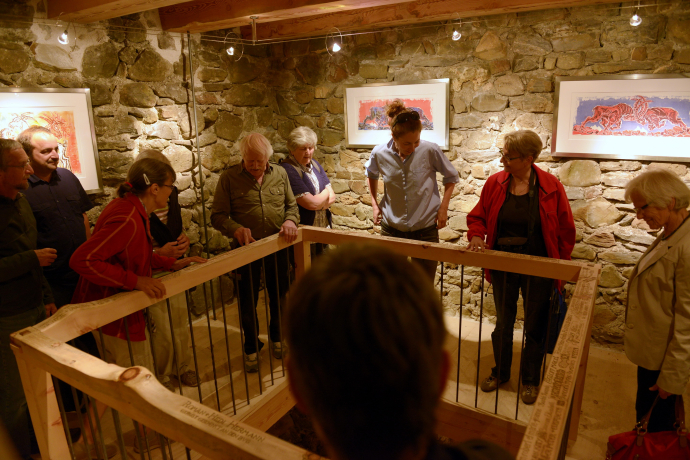Carving artist.
Marco Walli

Text and photo: Marietta Kobald, luaga.ch
No, he doesn't want to be called a lord of the castle, says Marco Walli firmly as he unloads reinforcing nets from a delivery truck at the foot of Strahlegg Castle together with a contractor. When asked if he hasn't had enough after more than eight years of renovation work on the castle, he just grins and says that he would like to cover another area in the castle courtyard with natural stones so that visitors can also sit down at a table outside. In the tower, where meter-high fir trees grew on the top of the wall until a few years ago, they can now sit at a knightly table, protected by a roof, and listen to the castle lord's stories.




Show all 5 images

Incessantly Marco is at work, no one would give him his more than 80 lenze. He bought the castle more than 50 years ago and built a log house next to it for himself and his family. Since then, he has repeatedly taken care of the decaying walls of the complex, but had to realize that his efforts were a futile endeavor. That's when he approached the Bündner Burgenverein and the preservation of historical monuments and asked for support. Since then, a lot has happened. During eight years, always in August, the board of the Bündner Burgenverein and many volunteers have taken care of the entire complex, sacrificing at least one week of vacation every year to repair the crumbling masonry. Since autumn 2013, the castle complex presents itself in excellent condition, the tower has even received stairs, landings and a roof and has thus become usable. Usable also for Marco's actual vocation, because it serves as an exhibition space for his carved and printed works of art.The carving began with a broken leg. Marco, the ski instructor, two-time CH champion and Parsenn Derby winner sat in his new house after a ski accident in 1966, unable to perform physically rigorous work. But to decorate the self-made china cabinet with notch carving, that was possible. He liked this work, so from then on, and with the support of his wife Gudrun, he devoted himself to carving, even making it his main occupation. The self-taught carver persistently taught himself the various carving techniques, initially applying them to everyday objects such as chairs, buffets, front doors and snack boards. Larger commissions followed, which challenged his creative ideas and drawing talent. In the meantime, countless works of art have left his small, well-organized workshop in Strahlegg, works of art made of wood on which entire life histories are recorded, cabinets not made of soft, easy-to-work-on Swiss stone pine, no, made of walnut or other types of hardwood supplemented with motifs made of cast pewter or with stones. Or works of art on paper, because this is also one of Marco's specialties; multicolored woodcuts with local subjects, which almost seem expressionistic. Currently, however, the printing block is at rest, too many flies, says Marco. One fly bite on the laid-out handmade paper and all the work would be for nothing. Instead, there is an almost finished large order in the workshop, a beautiful box made of walnut with pewter motifs - Marco used 23 kilos of this metal. Only inside the cabinet door something is missing, his abbreviation; it looks like the tower of Strahlegg Castle with a little pine tree on top.
Facts about castle Strahlegg
Strahlegg Castle is located on a hill at the bottom of the hamlet of Strahlegg in the municipality of Fideris and consists of the trapezoidal main castle, in the southwest corner of which rises the prominent tower. It is assumed that the castle was built in the first half of the 13th century. There is no documentary evidence from this period. In the 14th century the castle belonged to the Straiff. In 1403 it was awarded to Count Friedrich von Toggenburg, but already around 1550 it is described as a ruin by Ulrich Campell. Chronicler Jecklin saw it in better condition in 1870, because he still recognized apartments, vaults and other things. From the original outer castle, only weak remains of the ring are still visible. Traces of a wall leg extended from the castle to against the former Prättigauerstrasse, which until the middle of the 18th century did not lead through the valley floor, but over Strahlegg. It is further assumed that the tower once had an added, third storey made of wood, since there is no original access in the masonry of the tower. The current ground-level opening into the tower was only broken out in 1890 in order to operate a summer inn within the walls.
The legend of the Schanänn virgin
Near the Fideriser Au, on the footpath to the village of Jenaz, there used to be a small house, near which for many years a virgin, huge, dressed in white, with a pale face and flying dark hair, was seen silently floating around at night. Wanderers begged her for salvation and predicted future things. This pale seer was the Virgin of Shanann. To some she revealed the gruesome legend of the near ruins of her father's castle Strahlegg, the misdeeds of her father and the downfall of her family.
Her father, a rich man, lived not only in Strahlegg Castle but also in a house in the Fideriser Au. Once, when the girl was still in her cradle, a poor man came to him and asked for a gift. The rich man refused the same. "I will give you something," the poor man replied and gave him a nut. "Put it next to the big stone". He did as the poor man told him. "From the nut a tree grows, from the tree a branch, from the branch a bough, and from the bough a cradle will be made, and the child that will lie in that cradle, that shall redeem your daughter there. For she must guard your money until then". The rich man immediately wanted to dig the cursed nut out of the ground again, but instead of it a little branch was already sprouting towards him. Foreseeing further misfortune if he touched it, he left himself to despair, wandering through the vast field. His daughter grew up, but she did not become glad of her life; her beautiful, pale face testified to inner sorrow, and many years after her death she must guard her father's treasures until her redemption is effected in the form of a cradle.
Slightly abridged from Dietrich Jecklin "Folklore from the Grisons".
